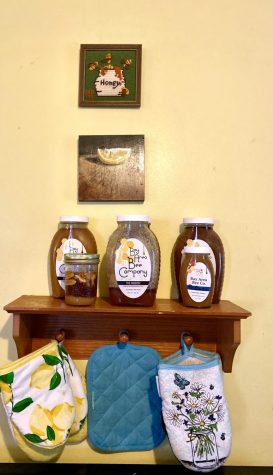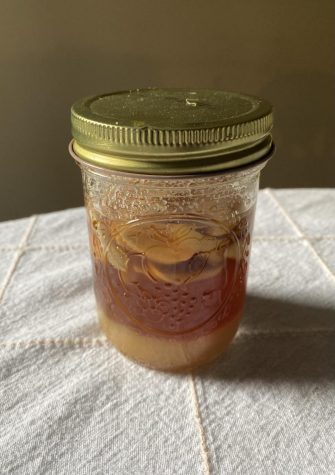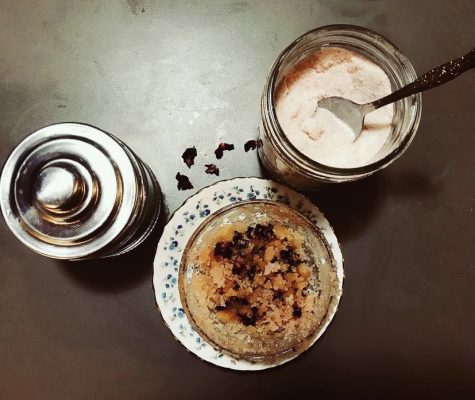5 Jewish Magic Rituals to Prepare for the New Year
Here are some delicious and grounding self-care practices to help us get ready for what’s to come.
Published August 25, 2021
This article originally appeared on Alma.
The High Holidays are approaching. Right now, we are in the Hebrew month of Elul. Elul is a time for metaphorical and literal sweeping, for dusting the cobwebs of our home and souls. The letters that make up Elul are aleph, lamed, vav, lamed, making up an acronym for “I am my beloved’s, and my beloved is mine” from Song of Songs. Song of Songs is about abundant love, mountains of spice, and milk and honey under the tongue. We could all use some of that energy right now.
So, as we approach the New Year, I’m here to share some delicious and grounding Jewish magic self-care practices to help us prepare for what’s to come.
ADVERTISEMENT
1. Take a milk and honey bath

In the Torah, in Exodus, the promised land is described as a land “flowing with milk and honey.” Ancient Jews believed that honey had healing properties, and it is common to eat honey for Rosh Hashanah to signify a sweet New Year. Our history is dipped in honey.
In a time when many of us feel disconnected from our bodies, taking a moment to take a milk and honey bath can be a transformative experience — the honey as medicine, the milk as nourishment.
Light some candles, turn on the tap, and pour liquid honey into the bath, letting it dissolve. Then pour in your milk of choice, animal or plant-based. Set an intention for your bath. Are you connecting with your body? Are you finding your spiritual land of milk and honey? You’ll be refreshed but sticky after, so finish your ritual with a quick shower.
2. Get into Jewish fermentation

Garlic is a plant of the Jewish diaspora. First grown in the Fertile Crescent in the Middle East, it has traveled with Jews for thousands of years, becoming part of our magic and food. In Jewish folklore, Jews often carried garlic in their pockets for protection against the evil eye. In the Talmud, the Jews often referred to themselves as garlic eaters, which the Romans later used as an antisemitic slur (jokes on them, because garlic is delicious). Garlic is also a natural antibiotic and, coupled with the medicinal properties of honey, creates a powerful potion. To make your garlic-infused honey you need:
- 3 bulbs of garlic (the fresher, the better)
- 1 cup of raw honey
- 1 pint-sized glass jar with lid
ADVERTISEMENT
First, peel your garlic and cut it into large chunks. Place it at the bottom of your clean jar, then pour your honey over the garlic. Loosely close the lid. Place your jar in a small bowl. For the next two weeks, flip your jar upside down. When the mixture reaches the bottom of the jar, flip it upright. For around two weeks, you will see some bubbling within your jar. Bubbling is part of the fermentation process, and some of your honey may spill out of the top of your jar.
After two weeks, close the lid tightly. You can wait one month to a year to taste your mixture. I recommend involving it in a ritual, whether tasting it during a new moon or waiting until Rosh Hashanah next year to try it, to ensure a protected and sweet New Year! Garlic honey is also great for a cold or with a chunk of fresh challah!
3. Make a salt and honey scrub

In Jewish folklore, dybbuks and similar creatures are blamed for creating chaos in new homes. To protect the house against harm, Jews would place salt in the corners of each room of a home. Early Jews would also rub the neck of newborn babies with salt to protect the infant against demons and ensure their health. If we use salt for protection, why not also protect our skin with a homemade salt and honey scrub?
To create a salt and honey scrub, all you need is a salt of choice (coarse salt is preferable), honey, olive oil, essential oil of your choice and a jar. You will want more salt than honey in your mixture, but you can adjust your scrub as you wish. First, mix the honey and olive oil, then slowly mix in the salt. Once you have a texture you like, add a couple of drops of your essential oil to scent. You will have refreshing and delicious honey and salt scrub to use throughout your New Year when you are done.
4. Create your mikveh

A mikveh is a ritual bath traditionally taken by women around their period. Historically, mikvehs were connected to purity culture and were a very gendered practice. In recent times, the practice of mikveh has powerfully been reclaimed by feminists and gender-nonconforming people as a practice that is open to all and is not about physical purity but to mark transitional and significant moments in life.
As we go into the New Year, think about what you want to let go of and what you want to keep holding. In what ways do you crave rebirth?
To create your own mikveh, gather a friend or two and head to a local body of water. I recommend young Jewish educator Madison Slobin’s “Rebirthing Ourselves to Rebirth Our World: A Feminist Mikveh Guide.” Her guide gives a great introduction to the mikveh, talks about reclaiming the ritual, and contains connected prayers and songs.
For an added magical element, you can cover yourself in the honey and salt scrub from above and wash it off in the water (make sure it is ecologically friendly to do so).
5. Align yourself with the Jewish moon cycle and the four Jewish New Years
The Jewish calendar is rooted in the moon cycles. Rosh Chodesh, a minor holiday, is the first day of every month, marked by the new moon. Moon and month share a word, chodesh, which means renewal. And Rosh Chodesh is connected with the presence of Shekinah, the divine feminine spirit of God, so Rosh Chodesh is often considered a holiday to celebrate women. All the practices I’ve shared would make beautiful Rosh Chodesh rituals.
To keep track of each moon, I use a Jewish planner called Verdant Dreams of Olam haBa: The World to Come 5782, created by Rebekah Erev and Nomy Lamm, two Kohenet or Jewish Priestesses. However, you could also download a Jewish calendar on your phone or just write down the days in any planner you currently use.
As you track the Jewish moons, there are four new months of note. While most Jews only celebrate one Jewish New Year in contemporary times, the Jewish calendar actually has four New Years, all of which fall on a new moon. The four Jewish New Years occur during Tishrei, Shevat, Nisan and Elul (Rosh Hashanah). Their existence reminds us that the Jewish calendar is one of constant renewal and rebirth.
I invite you to engage in and adapt any of these magical rituals as you see fit. As we enter the New Year, think about what you want to let go of and what you want to see transformed in your life. I hope that magical self-care practices can serve as a tool for you in the process. Chag Sameach! I wish you a sweet and magical New Year.















